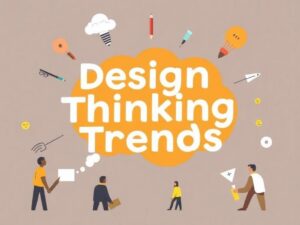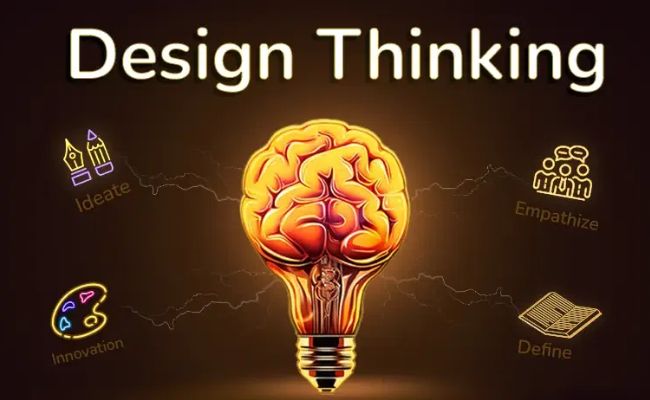Empowering Innovation with Design Thinking

The famous inventor and engineer Charles Kettering once observed, “If you have always approached it the same way, chances are it is not the right way.”
The primary challenge for companies lies in sustaining innovation to preserve or improve their position within their individual markets. Innovation cannot be treated as a single instance initiative. It must become ingrained in the company’s culture. But achieving innovation is not always straightforward. This is when design thinking becomes extremely helpful.
In the fast-changing business environment, organizations are continually striving to remain ahead, anticipate customer expectations, and create innovative solutions that genuinely connect with their target audience. The integration of design thinking, a powerful approach, revolutionized the approaches of organizations towards problem solving and developing new products. Design thinking focuses on the human experience, allowing organizations to create solutions that are practical, impactful, engaging, and truly enjoyable.
Design thinking originated to show engineers how to solve problems using the same creativity as designers. In 1959, in his book Creative Engineering, Arnold, a mechanical engineering professor at Stanford University, discussed the four fundamental aspects of design thinking that serve as a framework for fostering creativity and innovation in design and problem-solving. These areas are:
Novel Functionality:
Focusing on introducing new functions or features that did not previously exist. This involves creating innovative solutions that meet emerging needs or redefine how a product or service is used.
Improved Performance:
Enhancing the effectiveness or efficiency of an existing solution. This could include optimizing processes, increasing durability, reducing costs, or improving usability.
Increased Reliability:
Ensuring that solutions are dependable and consistent. This emphasizes designing systems or products that perform reliably under various conditions, reducing the likelihood of failure.
Enhanced Aesthetics:
Giving a design’s aesthetic and sensory appeal top priority. This involves considering the form, texture, color, and other aesthetic factors that add to the overall user experience and satisfaction.
Arnold’s ideas laid the groundwork for modern design thinking, emphasizing creativity and interdisciplinary approaches to solving complex problems.
Herbert A. Simon’s ‘The Sciences of the Artificial’ and Robert McKim’s ‘Experiences in Visual Thinking’ illustrate how this methodology evolved into a unique “mode of thinking” across both science and design engineering. In recent times, the term has witnessed a significant rise in prominence.
However, it’s not just a sudden trend—design thinking originated in the 1940s and ’50s, gradually evolving before gaining momentum in the mid-1970s. The 1980s saw the rise of human-centered design, and the 1990s brought further momentum with the founding of design consultancy IDEO. Since the beginning of the 21st century, business circles have accepted design thinking.
Innovating Through Empathy and Insight
Design thinking is a mindset and a process that encourages collaboration, creativity, and empathy, with the goal of developing solutions that are desirable, viable, and feasible.
At its core, design thinking is about understanding the needs, behaviors, and motivations of the end-users through immersive research and empathy-building exercises. Design thinking provides a hands-on method to prevent typical mistakes. Its principles focus on deliberately observing and analyzing how people use, interact with, and perceive products and services, rather than relying on assumptions made by designers or businesses. In its ideal form, design thinking requires developers to observe real user behavior and use those insights to refine and enhance the product or service until it provides the best possible experience. This “iterative” approach enables rapid prototyping, testing, and refinement, leading to faster time-to-market. Business leaders can also apply design thinking to rethink their operating models, infuse greater innovation into customer experience strategies, and broaden their market reach.
 The Design Thinking Process
The Design Thinking Process
While there are various models and frameworks for design thinking, most approaches follow a similar process that typically includes the following stages:
Empathize: Understanding the people for whom the solution is being built in great detail is the initial step in the design thinking process. In order to build empathy and identify unmet requirements or pain spots, this entails performing user research, watching how they behave, and becoming fully immersed in their experiences.
Define: The next phase is to precisely characterize the issue or challenge that needs to be resolved based on the knowledge acquired during the previous stage. This includes combining research results, finding patterns and critical insights, and framing the issue in a human-centric way.
Ideate: The ideation stage promotes expansive thinking and the creation of a large number of potential solutions when a clear problem statement is available. This is often done through brainstorming sessions, where team members build upon each other’s ideas and explore unconventional approaches without judging or evaluating them prematurely.
Prototype: Prototype creation follows the generation of promising ideas for testing and evaluation. Prototypes may vary from basic sketches or paper mockups to advanced digital or physical models, depending on the complexity of the solution and the design process phase.
Test: Testing is a crucial stage in the design thinking process, as it provides invaluable feedback and insights from real users. Prototypes are put in front of target users, who interact with them and provide feedback on their experiences, pain points, and desired improvements.
The repetitive and cyclical approach of design thinking means that these stages are not linear but rather cyclical, with the process often looping back to earlier stages based on the insights gained from testing and user feedback.
The Power of Design Thinking
Adopting a design thinking approach can bring numerous benefits to organizations across various industries and sectors:
User-Centric Solutions: Design thinking emphasizes prioritizing the needs and experiences of end-users, crafting solutions that align closely with their specific desires and expectations. This focus on the user enhances the chances of successful adoption, greater customer satisfaction, and sustained success over time.
Driving Innovation: Through the encouragement of exploratory thinking, hands-on experimentation, and quick prototyping, design thinking cultivates an innovative atmosphere. It empowers organizations to venture into unconventional ideas and creative strategies without the risk of being hindered by the fear of failure.
Interdisciplinary Collaboration: By fostering teamwork across diverse skill sets and expertise, design thinking supports a collaborative approach to problem-solving. This inclusivity helps establish a collective understanding of challenges and creates more holistic and balanced solutions.
Minimizing Risk and Expense: Through quick prototyping and user testing, design thinking enables early identification and resolution of potential challenges, minimizing the likelihood of expensive errors or poorly aligned solutions later in the development process.
Strategic Edge: Organizations that adopt design thinking and focus on delivering innovative, user-centered solutions are more likely to stand out from competitors and achieve a strong competitive advantage in their industries.
Blueprint for Organizational Success
While design thinking has its roots in product design and user experience, its principles and methodologies can be implemented to a wide range of challenges and industries, from service design to social innovation etc.
Effectively applying design thinking in an organization necessitates a change in perspective and a dedication to cultivating a culture rooted in empathy, teamwork, and a willingness to experiment.
Here are some key considerations for organizations looking to embrace design thinking:
Building a diverse team: Creating a varied team by putting together individuals with different backgrounds, skills, and perspectives. This diversity of thought and experience is essential for generating innovative ideas and developing holistic solutions.
Providing training and resources: Invest in training and resources to equip team members with the knowledge and tools necessary for effective design thinking. This may include workshops, courses, or engaging with experienced design thinking facilitators.
Creating an Inspiring Environment: Designate a space specifically designed to nurture creativity, facilitate collaboration, and encourage hands-on experimentation.
Promoting a Spirit of Experimentation: Build a workplace culture that values experimentation, views failures as opportunities for learning, and emphasizes ongoing iteration and improvement driven by user insights.
Securing Leadership Alignment: Gain the active support and commitment of organizational leaders to prioritize design thinking efforts, allocate necessary resources, and embed these practices into the overarching business objectives.
Tracking and Showcasing Results: Establish clear metrics and frameworks to evaluate the outcomes of design thinking initiatives and regularly share their value and impact with stakeholders across the organization.
Transforming Ideas into Impact
Numerous sectors and businesses have effectively implemented design thinking, producing creative and user-focused solutions. Here are few instances:
Product design: Apple, Uber and Airbnb are among the companies that have adopted design thinking in their designs to make products that are both functional and delightful for users.
Service design: Organizations in the service industry, such as banks, airlines, and healthcare providers, have leveraged design thinking to streamline processes, improve customer journeys, and deliver exceptional service experiences.
Business strategy: The principles of design thinking have been utilized in crafting business strategies, enabling organizations to identify emerging market opportunities, reshape their value propositions, and develop groundbreaking business models.
Organizational transformation: Design thinking methodologies have been used to facilitate organizational change and culture transformation, fostering collaboration, empathy, and a customer-centric mindset across teams and departments.
Social innovation: Non-profit organizations and social enterprises have adopted design thinking to tackle complex social challenges, develop sustainable solutions, and create positive impact within communities.
Revolutionizing Banking with Design Thinking
Design Thinking emerged as a critical necessity for the banking sector as customer preferences shifted drastically. People increasingly preferred to avoid visiting branches or ATM centers for their banking needs. Addressing this evolving demand required significant modifications to the entire infrastructure of branches and the banking ecosystem. This transformation pushed the banking industry to revisit and innovate its design strategies.
Its user-centric approach has helped financial institutions adapt to rapid technological advancements, evolving customer expectations, and regulatory pressures.
Enhanced Customer Experience
Design thinking places customers at the center of problem-solving, leading to products and services tailored to their needs. It enables the creation of intuitive digital platforms with streamlined interfaces and functionalities. For example, banks use customer insights to design personalized savings plans, investment portfolios, and mobile app features.
Accelerated Innovation
Financial institutions use design thinking to prototype and test ideas quickly, reducing time-to-market. For example, development of AI-driven chatbots to handle customer queries efficiently.
Financial Inclusion
Design thinking helps financial institutions understand barriers faced by underserved populations, leading to the creation of inclusive solutions. Complex banking processes, such as account opening and loan applications, are redesigned to be more user-friendly. For example, Mobile payment apps designed for rural areas with limited internet connectivity. Broader access to financial services, especially for low-income or rural users.
Improved Risk Management and Compliance
Design thinking helps simplify and streamline compliance requirements for users. For example, enhanced Know Your Customer (KYC) processes with user-friendly digital interfaces.
Cost Efficiency and Operational Streamlining
Design thinking guides the automation of repetitive processes, such as loan approvals or transaction processing. Financial institutions revamp processes to streamline operations and address inefficiencies and bottlenecks. For example, digitized and streamlined loan approval processes.
Employee Engagement and Teamwork
Design thinking encourages Interdisciplinary teamwork within financial institutions. Financial organizations invest in design thinking training to equip employees with problem-solving skills.
Sustainability and ESG Alignment
Design thinking enables banks to develop financial products aligned with ESG goals, such as green bonds or sustainable investment funds. By emphasizing transparency and user-centric solutions, design thinking enhances customer and stakeholder trust in sustainable banking practices.
Transformative Success Stories
Several banks have effectively embraced design thinking to elevate customer experiences.
DBS Bank in Singapore
DBS Bank has utilized design thinking to revolutionize its digital banking platform, significantly improving customer engagement and satisfaction. The bank adopted a designer’s mindset, using tools to develop deep empathy and insights about their customers. This process led to the creation of the 4Ds model—Discover, Define, Develop, and Deliver—a framework for customer-centric problem-solving. Within six months, the bank initiated around 250 to 300 customer journeys, engaging its 26,000- strong workforce across locations in Singapore, China, Taiwan, Hong Kong, India, and Indonesia.
These efforts involved observing customer interactions, analysing digital transaction data, and conducting in-depth interviews to uncover customer needs and aspirations. This approach paved the way for innovations such as the POSB Smart Senior program, which integrates health tracking and contactless payments to support the digital banking needs of seniors, demonstrating how empathy-driven design can empower a growing demographic.
 State Bank of India (SBI)
State Bank of India (SBI)
Sh. Rajnish Kumar, the former Chairman of SBI, emphasized the importance of customer convenience in designing YONO (You Only Need One), the bank’s flagship digital platform. The initiative was driven by a forward-thinking philosophy—”no looking back”—focused on building a fresh, innovative solution that prioritized customer needs. This mindset marked a shift from traditional banking practices, placing the customer at the heart of every design decision. YONO has since grown into one of the world’s largest digital banking platforms, exemplifying the success of user-centric design.
Capital One
Capital One adopted design thinking to enhance its digital and mobile experiences for both employees and customers. By redesigning processes like customer onboarding through tools such as OneView, a cloud-based content management solution, the bank eliminated inefficiencies and simplified the experience. This holistic approach has improved user experiences, leading to better app ratings and stronger customer engagement.
 Emerging Trends in Design Thinking
Emerging Trends in Design Thinking
Design thinking continues to evolve, adapting to modern challenges and opportunities. Here are some significant trends influencing the evolution:
Human-Centered Design
A growing focus on designing solutions that prioritize the emotional and practical needs of users has emerged. By incorporating storytelling, aesthetics, and personalization, designers create experiences that foster deeper emotional connections, enhancing engagement and loyalty.
Technological Integration
Progress in artificial intelligence (AI), virtual reality (VR), and the Internet of Things (IoT) have expanded the tools available for design thinking. These technologies allow for immersive, personalized experiences and the ability to anticipate user preferences, opening up new possibilities for innovation.
Interdisciplinary Collaboration
Designers are increasingly working with experts from diverse fields to create well- rounded solutions. Breaking down silos enables teams to approach complex problems from multiple perspectives, leading to more innovative and effective designs.
Sustainability
With rising environmental concerns, sustainable practices are becoming integral to the design process. Designers now consider a product’s entire lifecycle, from sourcing to disposal, exploring renewable resources, reducing waste, and creating recyclable products.
Data-Driven Design
Big data and analytics’ expansion provides designers with vital information about customer preferences and behaviour. This approach, driven by data, ensures the creation of designs that are not only aesthetically pleasing but also exceptionally functional and customized to meet user requirements.
By embracing these trends, design thinking continues to transform, enabling the creation of solutions that are innovative, user-focused, and impactful in addressing real-world challenges.
Conclusion
Design thinking represents a paradigm shift in problem-solving and innovation, placing human experience at the heart of every solution. Through promoting empathy, teamwork, and continuous experimentation, this approach enables organizations to create genuinely user-focused solutions that not only fulfill functional needs but also connect on an emotional level with their intended audience.
Embracing design thinking in an ever-changing business environment can give organizations a competitive advantage by helping them predict and address evolving customer demands, adjust to market shifts, and consistently innovate to remain ahead of the competition.
The impact of design thinking in banking and finance is transformative, enabling institutions to deliver customer-centric solutions, enhance operational efficiencies, and foster innovation. As the industry progresses with technological innovations and shifting consumer demands, design thinking will remain a critical enabler for success, helping institutions navigate complexities and create meaningful value for all stakeholders.
While adopting design thinking requires a mindset shift and a commitment to fostering a culture of experimentation and continuous learning, the rewards are substantial. Placing the requirements and interactions of customers as the focus enables organizations to develop solutions that have a real impact, boost customer contentment and dedication, and ultimately aid in long-lasting success and sustainable expansion.




